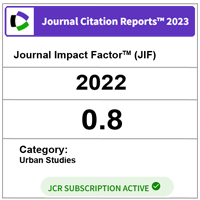The Value of Gotong-royong in the Mountainous Settlement of Kepuharjo Village at Pagerjurang Permanent Shelter in Yogyakarta, Indonesia
DOI:
https://doi.org/10.11113/ijbes.v8.n3.822Keywords:
Dwelling Space; Gotong Royong; Housing; Socio-cultural; ValueAbstract
Providing housing for refugees due to disasters is a common problem in countries prone to natural disasters. The eruption of Mount Merapi in Yogyakarta in 2010 has displaced the people of Kepuharjo Village to a new settlement in Pagerjurang permanent shelter. However, the process of settling in a new settlement requires adjustments because the people of Kepuharjo Village have been living on the slopes of Mount Merapi for generations. This research is a qualitative research which aims to find a reflection of the space-occupancy value system that occurs in the village of Kepuharjo at the Pagerjurang permanent shelter. The results of observations and interviews with 29 units show that the description of the activities and arrangement of the residential space in the Pagerjurang permanent shelter. The results showed that the motivation for the development of residential spaces is closely related to kinship and socio-cultural values in the daily life of the occupants. The socio-cultural reflection on the residential space of the Kepuharjo community in the Pagerjurang permanent shelter is in line with the social principles of mutual-cooperation (gotong-royong). Gotong-royong is expressed in the strengthening of space, expansion of space, and agreement of space.
References
Agusintadewi, N. K. (2014). Transforming Domestic Architecture: A Spatio-temporal Analysis of Urban Dwellings in Bali. Newcastle University.
Al-Ban, A. Z. G. (2016). Architecture And Cultural Identity In The Traditional Homes Of Jeddah. The University of Colorado at Denver. Retrieved from https://search.proquest.com.ezproxy.ugm.ac.id/docview/1795077484?accountid=13771 Retrieved onJune 2017
Atık, D., & Erdoğan, N. (2017). A model suggestion for determining physical and socio-cultural changes of traditional settlements in Turkey. A/Z ITU Journal of the Faculty of Architecture, 14(2): 81–93. https://doi.org/10.5505/itujfa.2017.62534
Eliade, M. (1959). The Sacred and the Profane: the Nature of Religion. Chicago: Harcourt Brace and World.
Faqih, M. (2005). Domestic Architecture and Culture Change. Re-ordering the use of space in Madurese housing. unpublished PhD Thesis. Faculty of Humanities and Social Sciences, University of Newcastle Upon Tyne.
Fatkhan, M. (2006). Kearifan lingkungan masyarakat lereng gunung merapi. Aplikasia. Jurnal Aplikasi Llmu-Ilmu Agama, 7(2): 107–121. Retrieved from http://digilib.uin-suka.ac.id/id/eprint/8328
Gunawan. (2015). Kearifan Masyarakat Lereng Merapi Bagian Selatan, Kabupaten Sleman – Daerah Istimewa Yogyakarta. Sosio Informa, 1(02): 189–212. https://doi.org/10.33007/inf.v1i2.148
Handel, A. (2019). What's in a home? Toward a critical theory of housing/dwelling. Environment and Planning C: Politics and Space, 37(6): 1045–1062. https://doi.org/10.1177/2399654418819104
Hillier, B., & Hanson, J. (1984). The social logic of space. Cambridge: Cambridge University Press.
Jerome, N. (2013). Application of the Maslow's hierarchy of need theory; impacts and implications on organizational culture, human resource and employee's performance. International Journal of Business and Management Invention, 2(3): 39–45.
Ju, S. R., Kim, D. Y., & Santosa, R. B. (2018). Dualism in the Javanese House and Transformation With focus on the houses of. Journal of Asian Architecture and Building Engineering, 7581(17:1), 71–78. https://doi.org/10.3130/jaabe.17.71
Koentjaraningrat. (1993). Manusia dan Kebudayaan di Indonesia. Jakarta: Penerbit Djambatan.
Maly, E., Iuchi, K., & Nareswari, A. (2015). Community-Based Housing Reconstruction and Relocation: REKOMPAK Program after the 2010 Eruption of Mt. Merapi, Indonesia. Journal of Social Safety Science, 27(27): 205–214. https://doi.org/10.11314/jisss.27.205
Marsoyo, A. (2012). Constructing Spatial Capital. Household Adaptation Strategies in Home-Based Enterprises in Yogyakarta. Faculty of Humanities and Social Sciences-University of Newcastle upon Tyne. Retrieved from https://theses.ncl.ac.uk/jspui/handle/10443/1452 Retrieved on December 2017
Mughal, M. A. Z. (2013). Domestic space and socio-spatial relationship in rural pakistan. South Asia Research, 35(2): 214–234. https://doi.org/10.1177/0262728015581287
Mullins, D. (2018). Achieving policy recognition for community-based housing solutions: the case of self-help housing in England. International Journal of Housing Policy, 18(1): 143–155. https://doi.org/10.1080/19491247.2017.1384692
Multi Donor Fund for Aceh and Nias, & J. R. F. (2012). Rekompak. Membangun Kembali Masyarakat Indonesia Pascabencana. Jakarta: Sekeretariat Multi Donor Fund untuk Aceh dan Nias dan Java Reconstruction Fund. Retrieved from https://www.scribd.com/document/397844721/Membangun-Kembali-Masyarakat-Indonesia-Pasca-Bencana Retrieved date: Februrary 2017
Paranagamage, I. P. D. H. (2006). Changing boundaries and meanings of the home: a case study of middle class houses in Sri Lanka. University of London, University College London (United Kingdom). Retrieved fromhttps://search.proquest.com.ezproxy.ugm.ac.id/docview/1427931075?accountid=13771 Retrieved date: June 2017
Rapoport, A. (1982). The meaning of the built environment : A nonverbal communication approach. California: The University of Arizona Press.
Ronald, A. (2005). Nilai-nilai arsitektur rumah tradisional Jawa: Sebuah akumulasi karya tulis yang diungkapkan karena rasa bangga menjadi orang Jawa yang harus penuh tenggang rasa. Bulaksumur, Yogyakarta: Gadjah Mada University Press
Santosa, R. B.(1997). Omah: The construction of meanings in Javanese domestic settings. ProQuest Dissertations and Theses, 115-115. Retrieved fromhttp://search.proquest.com/docview/304410596?accountid=13771 Retrieved on August, 2016
Santosa, R. B. (2000). Omah. Membaca makna rumah Jawa. Yogyakarta: Yayasan Bentang Budaya.
Seo, K. W. (2005). Spatial interpretation of housing. University of London, University College London (United Kingdom), ProQuest Dissertations Publishing, 2005. U602414. Retrieved from https://search.proquest.com/docview/1501974154?accountid=1371Retrieved date: June 2017
Setiadi, A., Andriessen, A., & Anisa, R. (2020). Post-occupancy evaluation of Pagerjurang permanent housing after the Merapi volcanic eruption. Journal of Architecture and Urbanism, 44(2): 145–151. https://doi.org/10.3846/jau.2020.11265
Siregar, J. P. (2014). Metodologi dasar space syntax dalam analisis konfigurasi ruang. Retrieved from https://docobook.com/queue/metodologi-dasar-space-syntax-dalam-analisis-konfigurasi-rua.html Retrieved date: April 2019
Subroto, T. Y. W.(1995). A study on the spatial linkage in urban settlement as an alternative tool for improving living environment in the cities of Java: An attempt to interpret and implement the vernacular space order into contemporary housing planning. unpublished PhD Thesis. The Course of Environmental Engineering, Graduate School of Engineering, Osaka University.
Tao, J., Chen, H., Zhang, S., & Xiao, D. (2018). Space and Culture : Isomerism in Vernacular Dwellings in Meizhou , Guangdong Province , China. Journal of Asian Architecture and Building Engineering, 17(1): 15–22. https://doi.org/10.3130/jaabe.17.15
Tjahjono, G.(1989). Cosmos, center, and duality in Javanese architectural tradition: The symbolic dimensions of house shapes in Kota Gede and surroundings. ProQuest Dissertations and Theses, 389-389 Retrieved from http://search.proquest.com/docview/303682297?accountid=13771 Retrieved on August 2016
Wongphyat, W., & Suzuki, H. (2018). Spatial Analysis of Traditional Thai Dwellings in the Phrapradaeng District. Journal of Asian Architecture and Building Engineering, 7(2): 225–232. https://doi.org/10.3130/jaabe.7.225
Downloads
Published
How to Cite
Issue
Section
License

This work is licensed under a Creative Commons Attribution-NonCommercial-ShareAlike 4.0 International License.
Copyright of articles that appear in International Journal of Built Environment and Sustainability belongs exclusively to Penerbit Universiti Teknologi Malaysia (Penerbit UTM Press). This copyright covers the rights to reproduce the article, including reprints, electronic reproductions or any other reproductions of similar nature.
Authors who publish with this journal agree to the following terms:
- This Journal applies Creative Commons Licenses of CC-BY-NC-SA
- Authors retain copyright and grant the journal right of publication with the work simultaneously licensed under a Creative Commons Attribution License that allows others to share the work with an acknowledgement of the work's authorship and publication in this journal.
- Authors are able to enter into separate, additional contractual arrangements for the non-exclusive distribution of the journal's published version of the work (e.g., post it to an institutional repository or publish it in a book), with an acknowledgement of its publication in this journal.
- Authors are permitted and encouraged to post their work online (e.g., in institutional repositories or on their website) prior to and during the submission process, as it can lead to productive exchanges, as well as earlier and greater citation of published work (See The Effect of Open Access).








